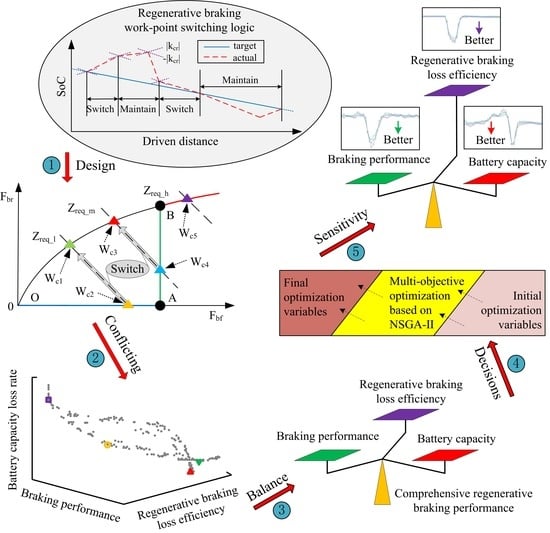Multi-Objective Optimization Study of Regenerative Braking Control Strategy for Range-Extended Electric Vehicle
Abstract
1. Introduction
2. Design of the Revised Braking Regenerative Control Strategy
2.1. Process of the Regenerative Braking Control Strategy
2.2. Realization of Braking Torque Based on OSR
2.3. Braking Work-Point Switching Logic of RRBCS
3. Multi-Objective Optimization (MOO) Algorithm for RRBCS of R-EEV
3.1. Description of MOO Problem for RRBCS
3.2. Optimization Objective Calculation
3.2.1. Braking Performance (BP)
3.2.2. Regenerative Braking Loss Efficiency (RBLE)
3.2.3. Battery Capacity Loss Rate (BCLR)
3.3. Optimization Decision Based on the Comprehensive Regenerative Braking Performance (CRBP)
4. Simulation and Result Discussion of the MOO Problem
4.1. Non-Dominated Sorting Genetic Algorithm (NSGA-II)
4.2. Simulation Analysis of NSGA-II
MOO Simulation Model
4.3. Results Analysis Based on Pareto Solution Sets
4.4. Optimization Decisions and Results Discussion
5. Discussion and Sensitivity Analysis of RRBCS Based on the Optimization Results
6. Conclusions
Author Contributions
Acknowledgments
Conflicts of Interest
References
- Du, J.; Ouyang, D. Progress of Chinese electric vehicles industrialization in 2015: A review. Appl. Energy 2016, 188, 529–546. [Google Scholar] [CrossRef]
- Chen, B.; Wu, Y.; Tsai, H. Design and analysis of power management strategy for range extended electric vehicle using dynamic programming. Appl. Energy 2014, 113, 1764–1774. [Google Scholar] [CrossRef]
- Ma, H.; Balthasar, F.; Tait, N.; Riera-Palou, X.; Harrison, A. A new comparison between the life cycle greenhouse gas emissions of battery electric vehicles and internal combustion vehicles. Energy Policy. 2012, 44, 160–173. [Google Scholar] [CrossRef]
- Qiu, C.; Wang, G. New evaluation methodology of regenerative braking contribution to energy efficiency improvement of electric vehicles. Energy Convers. Manag. 2016, 119, 389–398. [Google Scholar] [CrossRef]
- Lv, C.; Zhang, J.; Li, Y.; Yuan, Y. Novel control algorithm of braking energy regeneration system for an electric vehicle during safety–critical driving maneuvers. Energy Convers. Manag. 2015, 106, 520–529. [Google Scholar] [CrossRef]
- Guo, J.; Jian, X.; Lin, G. Performance evaluation of an anti-lock braking system for electric vehicle with a fuzzy sliding mode controller. Energies 2014, 7, 6459–6476. [Google Scholar] [CrossRef]
- Kumar, C.N.; Subramanian, S.C. Cooperative control of regenerative braking and friction braking for a hybrid electric vehicle. Proc. Inst. Mech. Eng. J. Automob. Eng. 2015, 230, 103–116. [Google Scholar] [CrossRef]
- Zhang, J.; Lv, C.; Gou, J.; Kong, D. Cooperative control of regenerative braking and hydraulic braking of an electrified passenger car. J. Automob. Eng. 2012, 226, 1289–1302. [Google Scholar] [CrossRef]
- Qiu, C.; Wang, G.; Meng, M.; Shen, Y. A novel control strategy of regenerative braking system for electric vehicles under safety critical driving situations. Energy 2018, 149, 329–340. [Google Scholar] [CrossRef]
- Yin, G.; Jin, X. Cooperative Control of Regenerative Braking and Antilock Braking for a Hybrid Electric Vehicle. Math. Probl. Eng. 2013, 4, 1–9. [Google Scholar] [CrossRef]
- Wei, Z.; Xu, J.; Halim, D. Braking force control strategy for electric vehicles with load variation and wheel slip considerations. IET Electr. Syst. Transp. 2017, 7, 41–47. [Google Scholar] [CrossRef]
- Li, L.; Zhang, Y.; Yang, C. Model predictive control-based efficient energy recovery control strategy for regenerative braking system of hybrid electric bus. Energy Convers. Manag. 2016, 111, 299–314. [Google Scholar] [CrossRef]
- Wu, J.; Wang, X.; Li, L.; Qin, C.; Du, Y. Hierarchical control strategy with battery aging consideration for hybrid electric vehicle regenerative braking control. Energy 2018, 145, 301–312. [Google Scholar] [CrossRef]
- Han, J.; Park, Y.; Park, Y. Cooperative regenerative braking control for front-wheel-drive hybrid electric vehicle based on adaptive regenerative brake torque optimization using under-steer index. Int. J. Automot. Technol. 2014, 15, 989–1000. [Google Scholar] [CrossRef]
- Le Solliec, G.; Chasse, A.; Geamanu, M. Regenerative braking optimization and wheel slip control for a vehicle with in-wheel motors. IFAC Proc. Vol. 2013, 46, 542–547. [Google Scholar] [CrossRef]
- Roumila, Z.; Rekioua, D.; Rekioua, T. Energy management based fuzzy logic controller of hybrid system wind/photovoltaic/diesel with storage battery. Int. J. Hydrog. Energy 2017, 42, 19525–19535. [Google Scholar] [CrossRef]
- Aksjonov, A.; Vodovozov, V.; Augsburg, K.; Petlenkov, E. Design of regenerative anti-lock braking system controller for 4 in-wheel-motor drive electric vehicle with road surface estimation. Int. J. Automot. Technol. 2018, 19, 727–742. [Google Scholar] [CrossRef]
- Maia, R.; Silva, M.; Araújo, R.; Nunes, U. Electrical vehicle modeling: A fuzzy logic model for regenerative braking. Expert Syst. Appl. 2015, 42, 8504–8519. [Google Scholar] [CrossRef]
- Topalov, A.V.; Oniz, Y.; Kayacan, E.; Kaynak, O. Neuro-fuzzy control of antilock braking system using sliding mode incremental learning algorithm. Neurocomputing 2011, 74, 1883–1893. [Google Scholar] [CrossRef]
- Xu, G.; Xu, K.; Zheng, C.; Zhang, X.; Zahid, T. Fully electrified regenerative braking control for deep energy recovery and maintaining safety of electric vehicles. IEEE Trans. Veh. Technol. 2016, 65, 1186–1198. [Google Scholar] [CrossRef]
- Shashi, A.; Wang, G.; An, Q. Using the Pareto set pursuing multi-objective optimization approach for hybridization of a plug-in hybrid electric vehicle. J. Mech. Des. 2012, 134, 503–509. [Google Scholar]
- Yang, G.; Li, S.; Qu, J. Multi-objective optimization of hybrid electrical vehicle based on Pareto optimality. J. Shanghai Jiaotong Univ. 2012, 46, 1297–1303. [Google Scholar]
- Yang, G.; Zhang, A.; Li, S.; Wang, Y.; Wang, Y.; Xie, Q. Multi-objective evolutionary algorithm based on decision space partition and its application in hybrid power system optimization. Appl. Intell. 2017, 46, 827–844. [Google Scholar] [CrossRef]
- Nandi, A.K.; Chakraborty, D.; Vaz, W. Design of a comfortable optimal driving strategy for electric vehicles using multi-objective optimization. J. Power Sources 2015, 283, 1–18. [Google Scholar] [CrossRef]
- Li, J.; Jin, X.; Xiong, R. Multi-objective optimization study of energy management strategy and economic analysis for a range-extended electric bus. Energy Policy. 2017, 194, 798–807. [Google Scholar] [CrossRef]
- Jiang, Y.; Jiang, J.; Zhang, C.; Zhang, W.; Gao, Y.; Guo, Q. Recognition of battery aging variations for LiFePO4 batteries in 2nd use applications combining incremental capacity analysis and statistical approaches. J. Power Sources 2017, 360, 180–188. [Google Scholar] [CrossRef]
- Wang, J.; Purewal, J.; Liu, P.; Hicks-Garner, J.; Soukazian, S.; Sherman, E. Degradation of lithium ion batteries employing graphite negatives and nickel–cobalt–manganese oxide+ spinel manganese oxide positives: Part 1, aging mechanisms and life estimation. J. Power Sources 2014, 269, 937–948. [Google Scholar] [CrossRef]
- Abdel-Monem, M.; Trad, K.; Omar, N.; Hegazy, O.; Peter, V.D.B.; Van Mierlo, J. Influence analysis of static and dynamic fast-charging current profiles on ageing performance of commercial lithium-ion batteries. Energy 2017, 120, 179–191. [Google Scholar] [CrossRef]
- Kamjoo, A.; Maheri, A.; Dizqah, A.M.; Putrus, G.A. Multi-objective design under uncertainties of hybrid renewable energy system using NSGA-II and chance constrained programming. Int. J. Electr. Power Energy Syst. 2016, 74, 187–194. [Google Scholar] [CrossRef]
- Deb, K.; Pratap, A.; Agarwal, S.; Meyarivan, T. A fast and elitist multi-objective genetic algorithm: NSGA-II. IEEE Trans. Evol. Comput. 2002, 6, 182–197. [Google Scholar] [CrossRef]

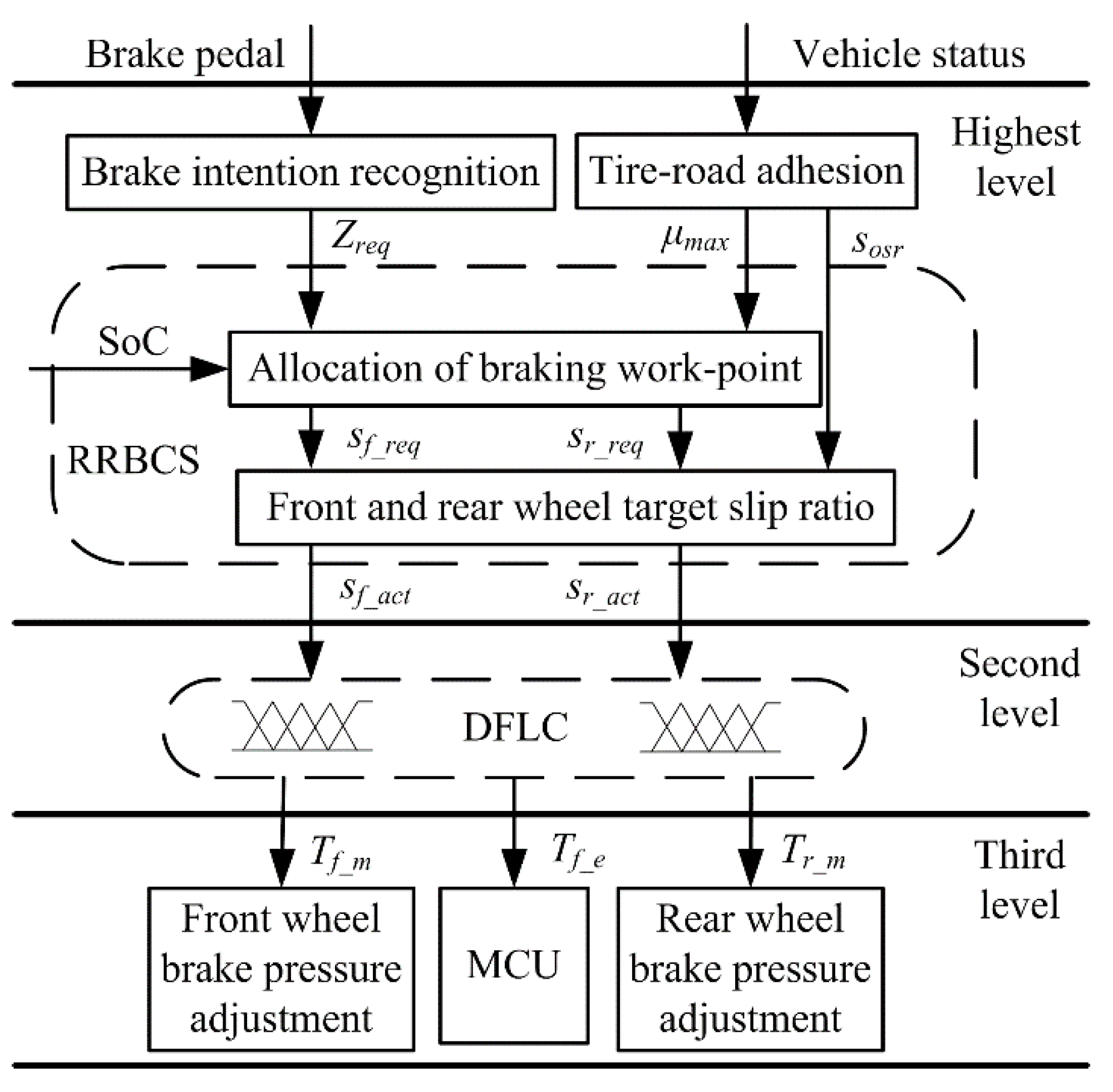
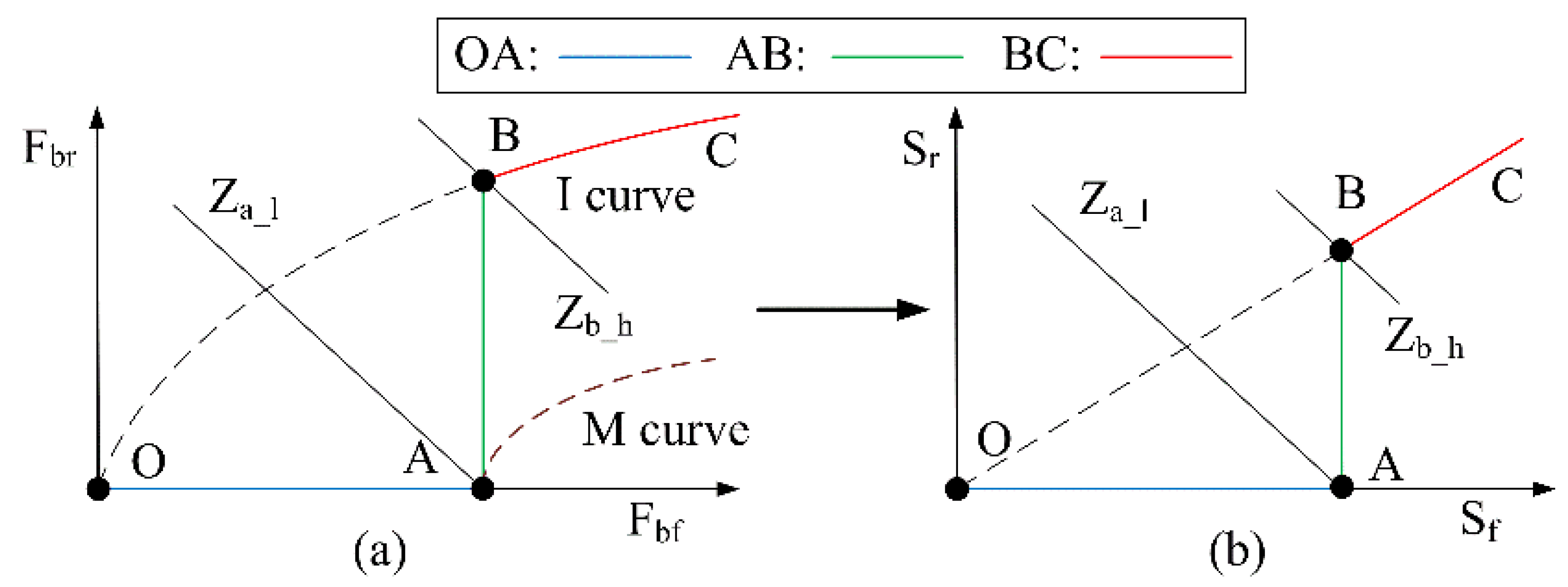
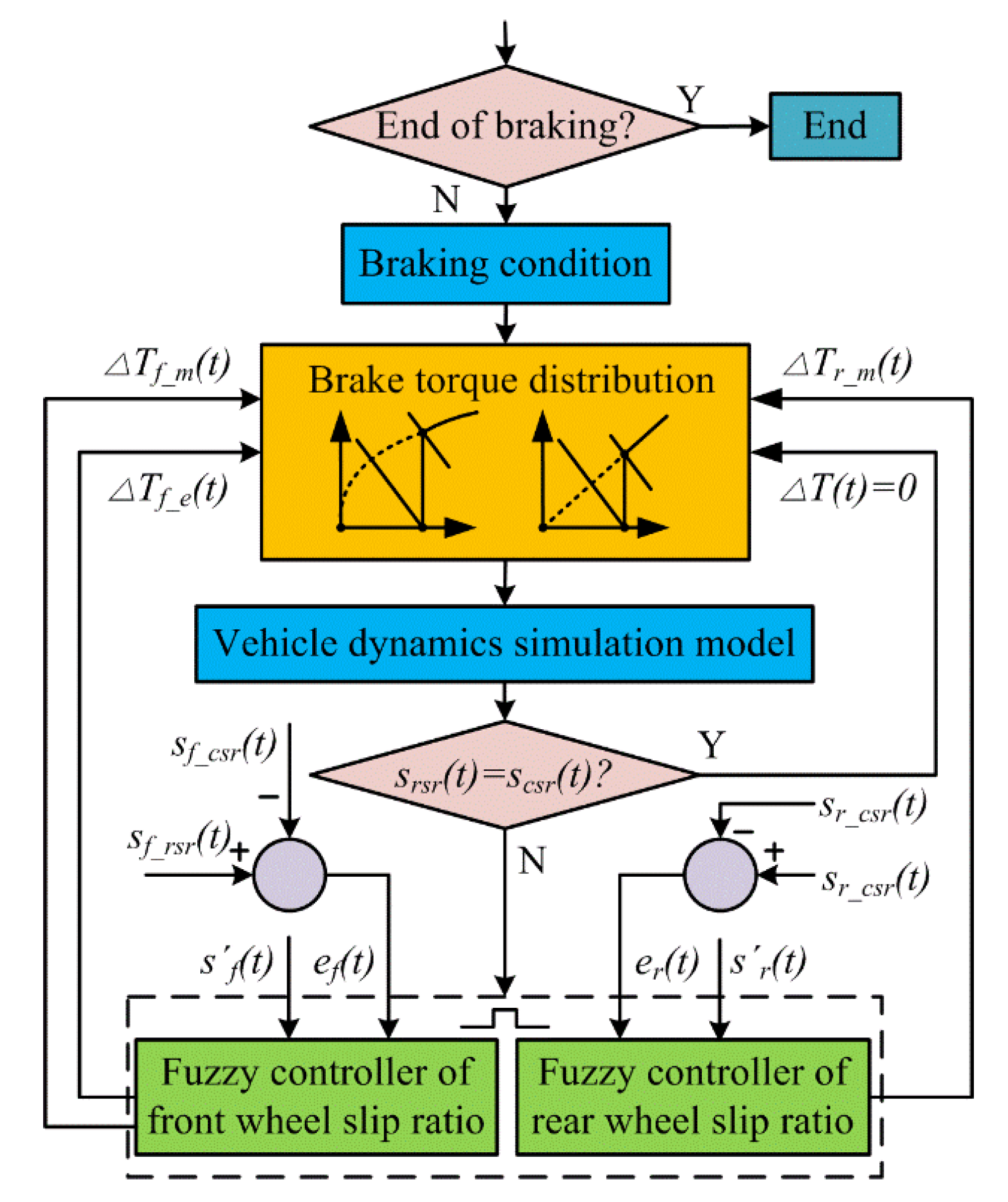


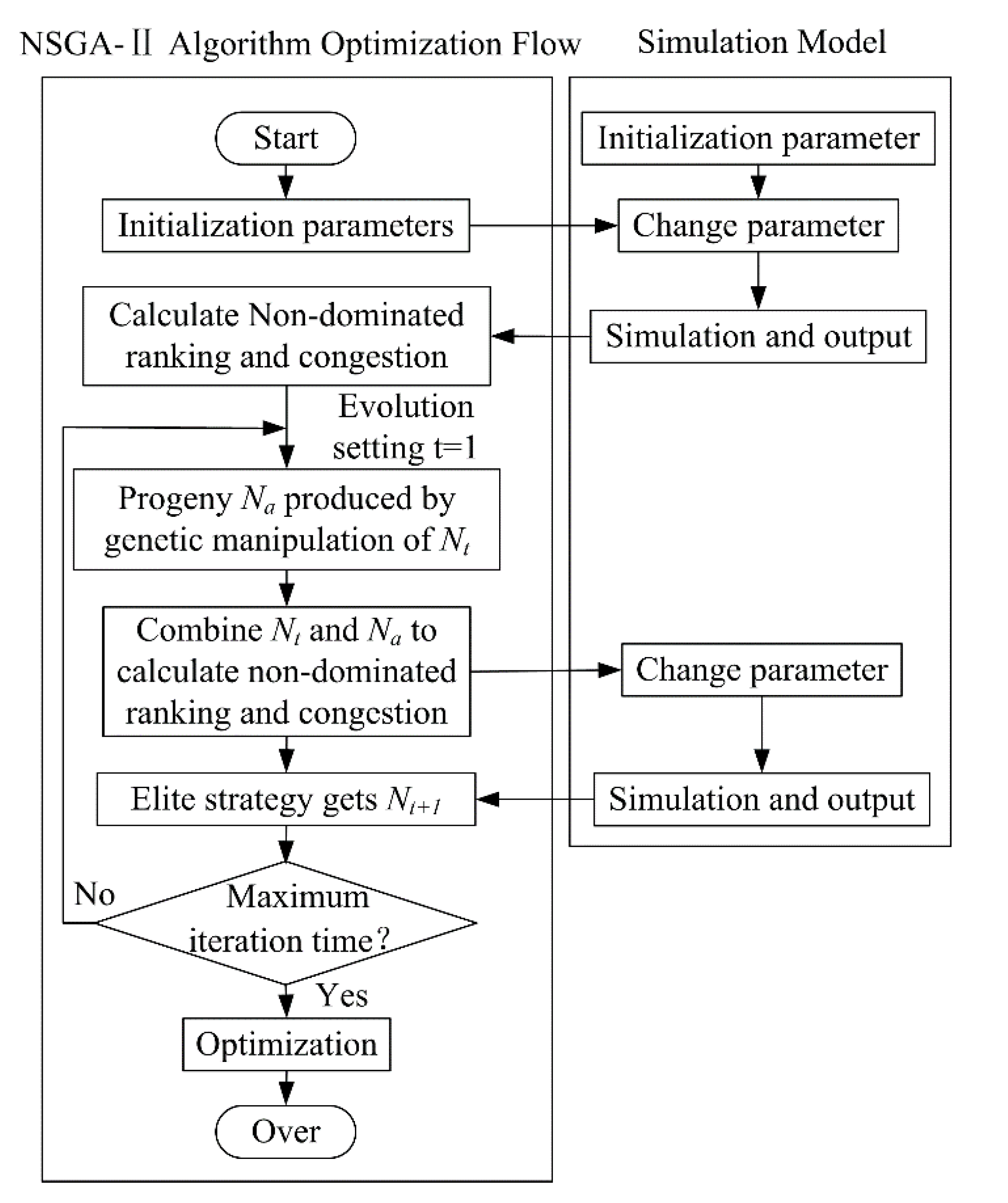
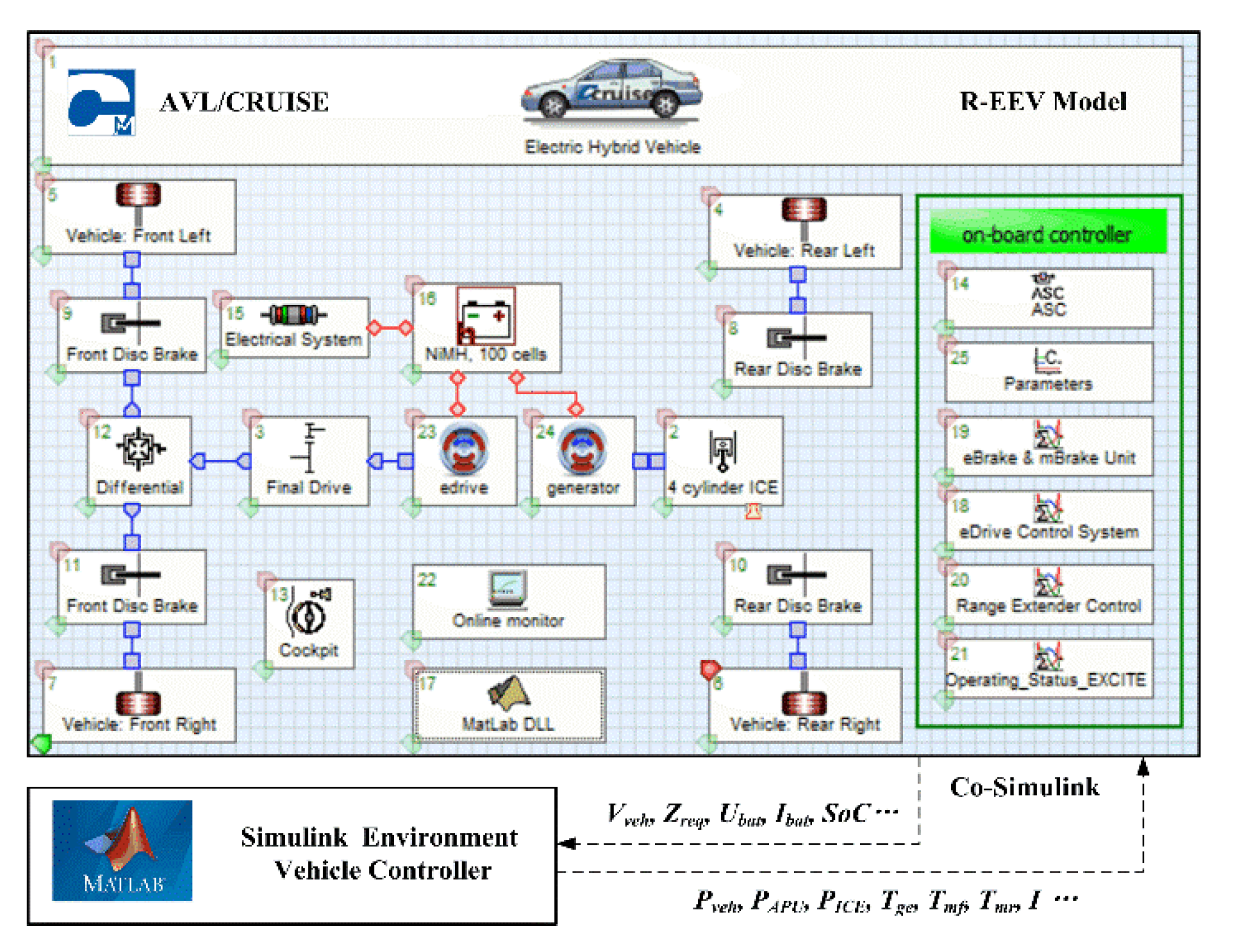


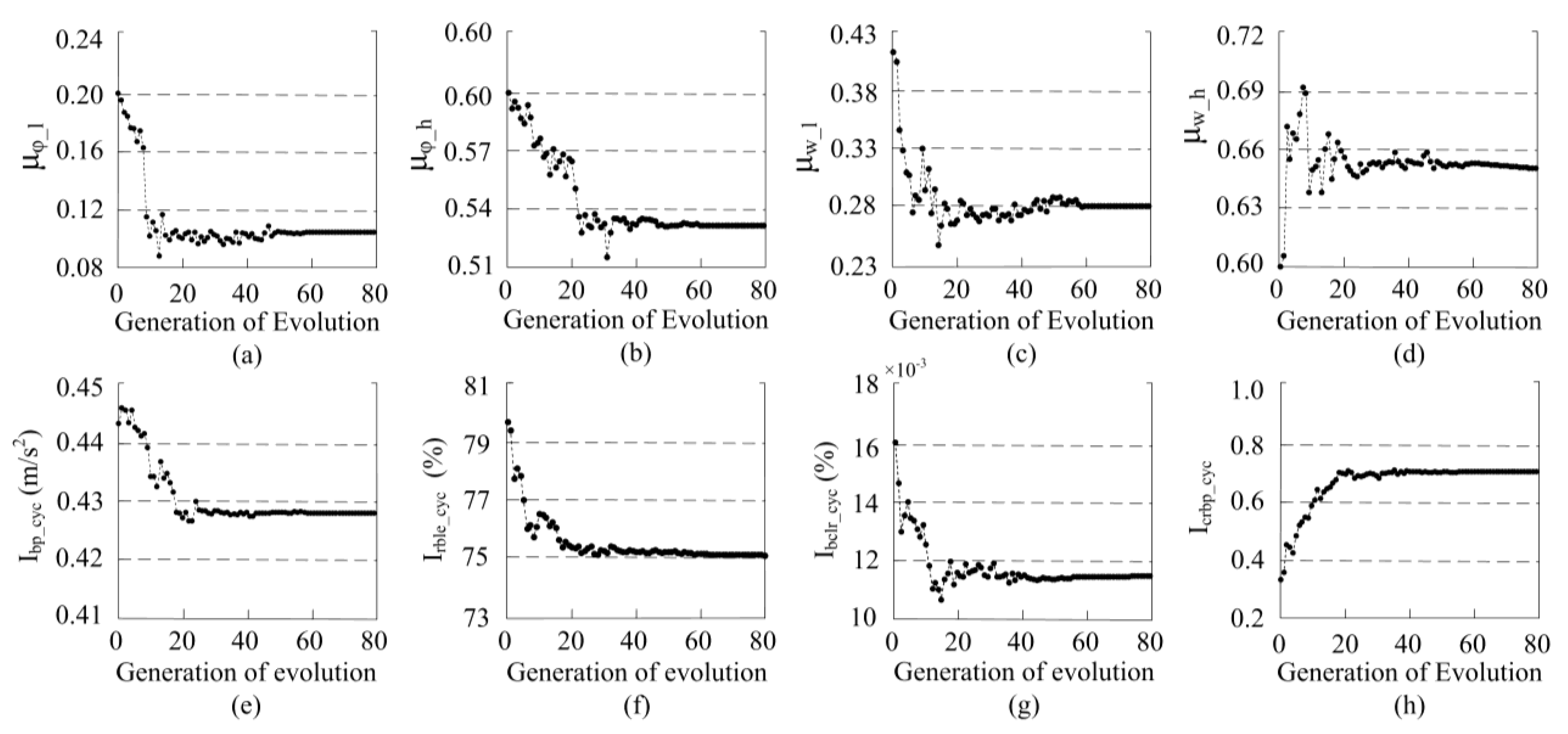

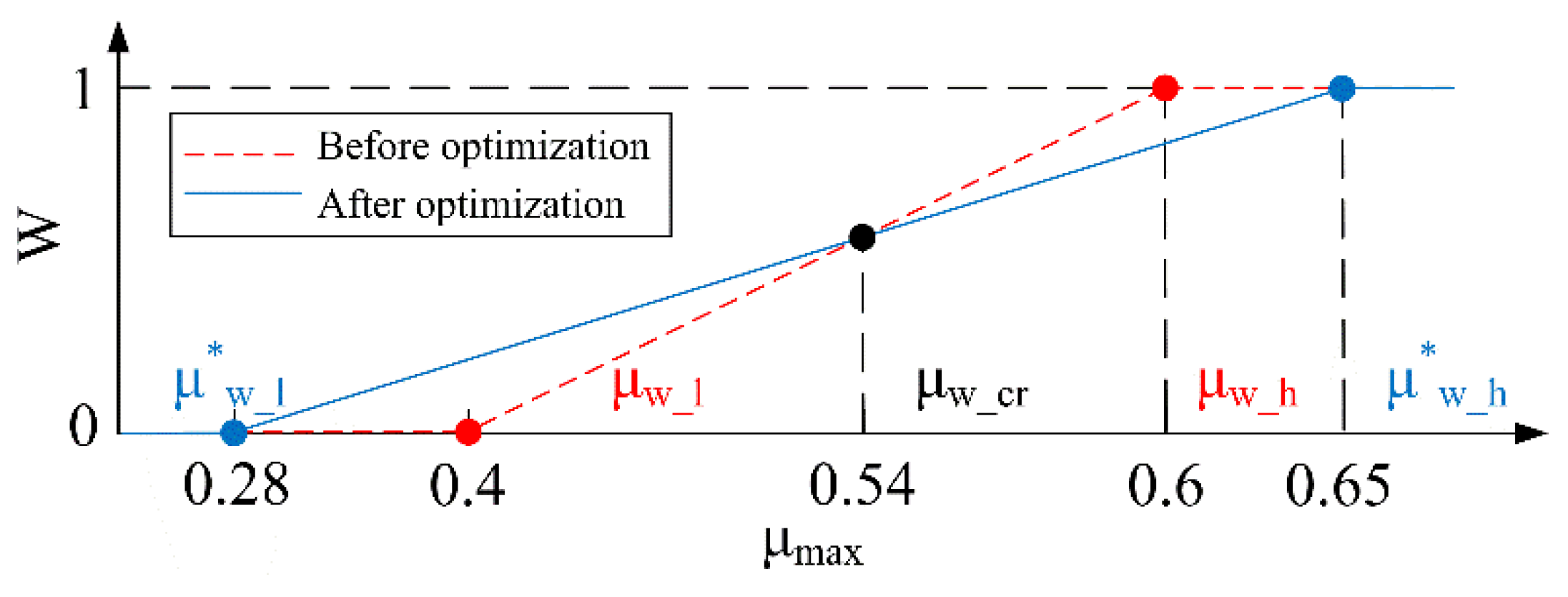


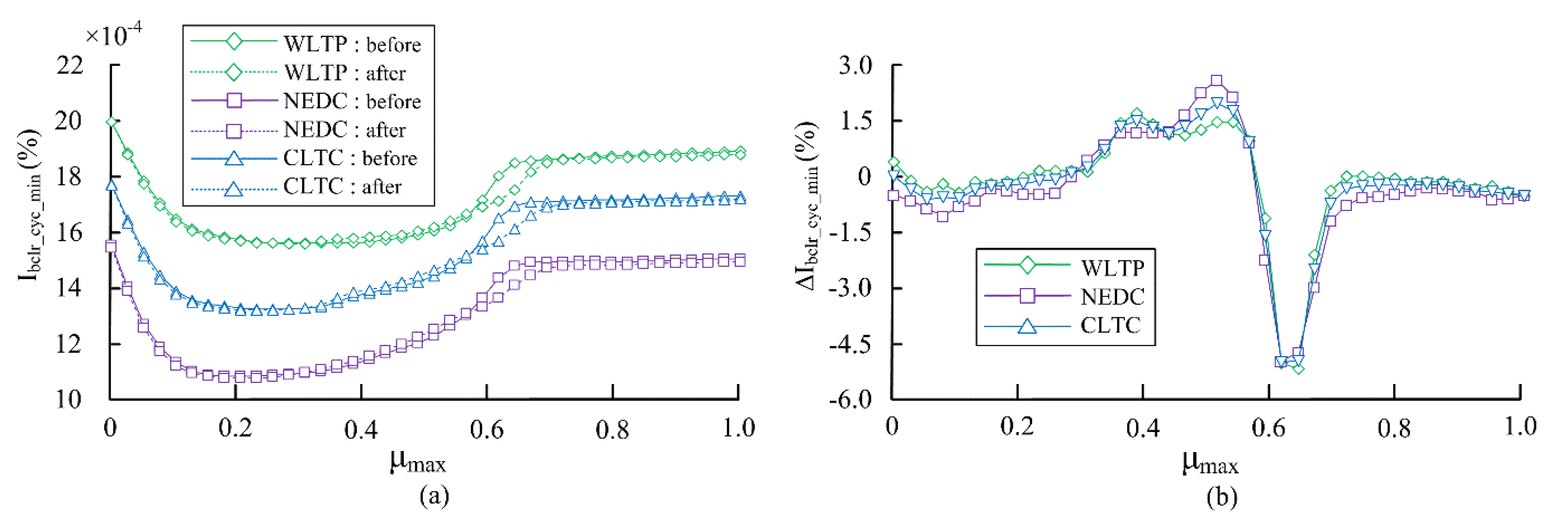
| Parameter | Value | Parameter | Value |
|---|---|---|---|
| Full load weight (kg) | 1700 | Battery capacity (kWh) | 20 |
| Wheelbase (mm) | 2865 | Initial SoC (state of charge) | 0.8 |
| Distance from front axle to centroid (mm) | 1352 | Diameter of front wheel cylinder (mm) | 56.95 |
| Distance from rear axle to centroid (mm) | 1513 | Diameter of rear wheel cylinder (mm) | 33.82 |
| Centroid height (mm) | 500 | Diameter of master cylinder (mm) | 18 |
| Drag area (m2) | 1.66 | Effective radius of front brake rotor (mm) | 0.235 |
| Correction coefficient of rotating mass | 1.1 | Effective radius of rear brake rotor (mm) | 0.227 |
| Mechanical efficiency | 0.96 | Brake pedal leverage ratio | 3.5 |
| Transmission reduction ratio | 4.2 | Diameter of pedal travel simulator (mm) | 15 |
| Item (High Adhesion) | Solution 1 (Best BP) | Solution 2 (Lowest RBLE) | Solution 3 (Lowest BCLR) | Solution 4 (Best CRBP) |
|---|---|---|---|---|
| [μφ_l, μφ_h, μw_l, μw_h] | [0.17, 0.51, 0.44, 0.77] | [0.21, 0.48, 0.24, 0.49] | [0.22, 0.62, 0.29, 0.78] | [0.18,0.53, 0.29, 0.66] |
| Ibp_cyc (m/s2) | 0.0407 | 0.0473 | 0.0409 | 0.0421 |
| Irble_cyc | 0.76 | 0.68 | 0.73 | 0.72 |
| Ibclr_cyc (%) | 2.9 | 11.7 | 2.3 | 4.7 |
| Icrbp_cyc | 0.61 | 0.55 | 0.66 | 0.83 |
| Item (Medium adhesion) | Solution 1 (Best BP) | Solution 2 (Lowest RBLE) | Solution 3 (Lowest BCLR) | Solution 4 (Best CRBP) |
| [μφ_l, μφ_h, μw_l, μw_h] | [0.15, 0.58, 0.43, 0.75] | [0.23, 0.47, 0.22, 0.47] | [0.21, 0.60, 0.28, 0.78] | [0.12,0.54, 0.28, 0.66] |
| Ibp_cyc (m/s2) | 0.0411 | 0.0475 | 0.0415 | 0.0426 |
| Irble_cyc | 0.76 | 0.69 | 0.75 | 0.73 |
| Ibclr_cyc (%) | 3.1 | 12.3 | 2.8 | 4.8 |
| Icrbp_cyc | 0.60 | 0.54 | 0.63 | 0.81 |
| Item (Low adhesion) | Solution 1 (Best BP) | Solution 2 (Lowest RBLE) | Solution 3 (Lowest BCLR) | Solution 4 (Best CRBP) |
| [μφ_l, μφ_h, μw_l, μw_h] | [0.05, 0.58, 0.41, 0.72] | [0.03, 0.44, 0.22, 0.47] | [0.11, 0.61, 0.26, 0.78] | [0.05,0.53, 0.27, 0.64] |
| Ibp_cyc (m/s2) | 0.0415 | 0.0476 | 0.0428 | 0.0432 |
| Irble_cyc | 0.78 | 0.70 | 0.77 | 0.75 |
| Ibclr_cyc (%) | 3.6 | 12.4 | 4.1 | 4.9 |
| Icrbp_cyc | 0.58 | 0.51 | 0.62 | 0.77 |
| Item | Optimization Variables | Evaluation Indexes | ||||||
|---|---|---|---|---|---|---|---|---|
| μφ_l | μφ_h | μw_l | μw_h | Ibp_cyc | Irble_cyc | Ibclr_cyc | Icrbp_cyc | |
| First generation | 0.20 | 0.40 | 0.40 | 0.60 | 0.443 | 79.4% | 16.1% | 0.32 |
| Last generation | 0.10 | 0.53 | 0.28 | 0.65 | 0.428 | 75.1% | 11.2% | 0.71 |
| Parameter Za_l | High Adhesion | Medium Adhesion | Low Adhesion |
|---|---|---|---|
| Before optimization | 0.400 | 0.400 | 0.0000 |
| After optimization | 0.400 | 0.346 | 0.0757 |
| Parameter Zb_h | High adhesion | Medium adhesion | Low adhesion |
| Before optimization | 0.600 | 0.400 | 0.0000 |
| After optimization | 0.600 | 0.533 | 0.1318 |
| Item | Ibp_cyc | Irble_cyc | Ibclr_cyc | ||||||
|---|---|---|---|---|---|---|---|---|---|
| WLTP | NEDC | CLTC | WLTP | NEDC | CLTC | WLTP | NEDC | CLTC | |
| μmax | 0.38 | 0.38 | 0.38 | 0.42 | 0.42 | 0.42 | 0.64 | 0.62 | 0.62 |
| ∆Imax (%) | −4.7 | −7.1 | −5.9 | −16.1 | −19.3 | −18.4 | −4.9 | −4.8 | −4.8 |
© 2020 by the authors. Licensee MDPI, Basel, Switzerland. This article is an open access article distributed under the terms and conditions of the Creative Commons Attribution (CC BY) license (http://creativecommons.org/licenses/by/4.0/).
Share and Cite
Liu, H.; Lei, Y.; Fu, Y.; Li, X. Multi-Objective Optimization Study of Regenerative Braking Control Strategy for Range-Extended Electric Vehicle. Appl. Sci. 2020, 10, 1789. https://doi.org/10.3390/app10051789
Liu H, Lei Y, Fu Y, Li X. Multi-Objective Optimization Study of Regenerative Braking Control Strategy for Range-Extended Electric Vehicle. Applied Sciences. 2020; 10(5):1789. https://doi.org/10.3390/app10051789
Chicago/Turabian StyleLiu, Hanwu, Yulong Lei, Yao Fu, and Xingzhong Li. 2020. "Multi-Objective Optimization Study of Regenerative Braking Control Strategy for Range-Extended Electric Vehicle" Applied Sciences 10, no. 5: 1789. https://doi.org/10.3390/app10051789
APA StyleLiu, H., Lei, Y., Fu, Y., & Li, X. (2020). Multi-Objective Optimization Study of Regenerative Braking Control Strategy for Range-Extended Electric Vehicle. Applied Sciences, 10(5), 1789. https://doi.org/10.3390/app10051789




